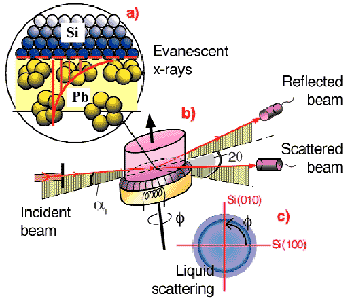- Home
- Users & Science
- Scientific Documentation
- ESRF Highlights
- ESRF Highlights 2000
- Soft Condensed Matter
- Local Structure of Liquid Pb at the Solid-Liquid Interface Si(001)-Pb(liq.)
Local Structure of Liquid Pb at the Solid-Liquid Interface Si(001)-Pb(liq.)
The local point symmetry in simple monatomic liquids is one of the fundamental open questions in the science of condensed matter. The importance of local liquid symmetries has long been highlighted by the conjecture that simple monatomic liquids with centrosymmetric interaction may be composed of icosahedral building blocks [1,2]. However, these randomly orientated, mobile structures have remained inaccessible to experiments due to the unavoidable averaging which allows only a determination of the isotropic radial distribution function.
At solid-liquid interfaces the crystalline potential acts on the adjacent liquid in two ways: (a) Normal to the wall a density oscillation appears within an interfacial layer of thickness ![]() *. (b) In the lateral direction r|| the periodic wall potential V(r||) imposes its periodicity onto the "contact-liquid". In the case of incompatible materials the wall exhibits a small lateral periodic perturbation potential V(r||) which is incommensurate with the liquid nearest-neighbour distance. Consequently, there is no wall-induced long-range translational ordering. Despite this, the substrate potential may still be strong enough to capture a fraction of the predicted bulk liquid building blocks in preferred orientations giving rise to orientational alignment. A properly designed X-ray scattering experiment on these aligned liquid fragments should give access to their local symmetry. For the experiment we have chosen the combination of liquid lead which exhibits closed-packed fcc structure (aPb = 4.95 Å in the solid state) in contact with Si(001) (diamond lattice with aSi = 5.43 Å).
*. (b) In the lateral direction r|| the periodic wall potential V(r||) imposes its periodicity onto the "contact-liquid". In the case of incompatible materials the wall exhibits a small lateral periodic perturbation potential V(r||) which is incommensurate with the liquid nearest-neighbour distance. Consequently, there is no wall-induced long-range translational ordering. Despite this, the substrate potential may still be strong enough to capture a fraction of the predicted bulk liquid building blocks in preferred orientations giving rise to orientational alignment. A properly designed X-ray scattering experiment on these aligned liquid fragments should give access to their local symmetry. For the experiment we have chosen the combination of liquid lead which exhibits closed-packed fcc structure (aPb = 4.95 Å in the solid state) in contact with Si(001) (diamond lattice with aSi = 5.43 Å).
In order to achieve the extraordinary interface sensitivity necessary for this experiment, the geometry of grazing-angle diffraction (GAD) has been modified in such a way that total internal reflection occurs at a deeply buried interface exhibiting a sizeable electron density difference across the interface. Applying this geometry with high-energy photons at beamline ID15A, an evanescent wave is produced within a thin liquid layer close to the deeply buried interface which is subject to scattering at the density inhomogenities within the liquid (see Figure 38). By this optical trick we have produced a 50 Å probing beam in a deeply buried interface.
 |
Fig. 38: a) A well-defined high-energy X-ray microbeam (E = 71.5 keV, 8 µm vertical size) penetrates a cylindrical Si solid (r = 20 mm) from the side and impinges to the Si-Pb interface. For angles below the critical angle of total internal reflection (
|
The experimental observation for an azimuthal scan within a 90°-segment of the non-reconstructed 4-fold Si(001) wall is shown in Figure 39. A modulation of the liquid scattering intensity is found. We observe five intensity maxima with a fixed epitaxial relationship to the substrate. We find this modulation only for momentum transfer values close to the maximum of the liquid structure factor. The analysis of the modulation amplitude allows determination of the orientational part of the interface potential between 50 meV and 90 meV. The observed peak positions give strong evidence for the formation of pentagonal correlations arranged around the 4-fold coordinated Si-sites.
 |
Fig. 39: Scattering at the Pb(liq.)-Si(001) interface. (a) Pb interfacial liquid structure factor measured in arbitrary units. The evanescent X-ray wave "tunnels" 55 Å deep into the liquid Pb. (b) Azimuthal distribution of the liquid scattering at the first diffraction maximum. The line is a fit of a sinusoidal to the experimental data (circles). The two lower lines show the projected electron density overlap of the pentagonal arrangement with the underlying Si substrate versus rotation for the top site position (full curve) and the hollow site position (dashed dotted curve). The epitaxial relation to the Si substrate is indicated by vertical lines.
|
The measurements comprise the first successful direct observation of the fivefold local symmetry of liquid lead. They provide an experimental portrait of the icosahedral fragments predicted for all close-packed monatomic liquids. This unique information has become possible by exploiting two experimental features: We capture and align the local liquid building blocks at a non-wet Si(001) wall and observe the local 5-fold point symmetry of the associated liquid scattering using evanescent X-ray waves.
References
[1] J.D. Bernal, Nature 185, 68 (1960).
[2] D.R. Nelson, F. Spaepen, Sol. Stat. Phys., 42, 1 (1989).
Principal Publication and Authors
H. Reichert (a), O. Klein (a), H. Dosch (a), M. Denk (a), V. Honkimäki (b), T. Lippmann (c) and G. Reiter (d), Nature 408, 839 (2000).
(a) Max-Planck-Institut für Metallforschung, Stuttgart (Germany)
(b) ESRF
(c) HASYLAB, Hamburg (Germany)
(d) University of Houston (USA)



